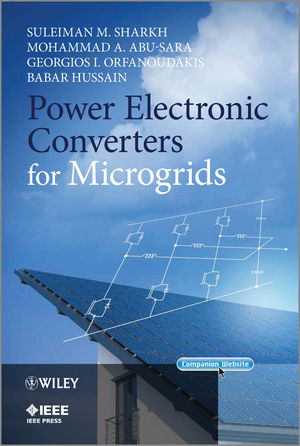Power Electronic Converters for MicrogridsISBN: 978-0-470-82403-0
Hardcover
352 pages
June 2014, Wiley-IEEE Press
 |
||||||
Preface xiii
Acknowledgments xv
1 Introduction 1
1.1 Modes of Operation of Microgrid Converters 2
1.1.1 Grid Connection Mode 2
1.1.2 Stand-Alone Mode 3
1.1.3 Battery Charging Mode 3
1.2 Converter Topologies 4
1.3 Modulation Strategies 6
1.4 Control and System Issues 7
1.5 Future Challenges and Solutions 9
References 10
2 Converter Topologies 13
2.1 Topologies 13
2.1.1 The Two-Level Converter 13
2.1.2 The NPC Converter 14
2.1.3 The CHB Converter 15
2.2 Pulse Width Modulation Strategies 16
2.2.1 Carrier-Based Strategies 17
2.2.2 SVM Strategies 22
2.3 Modeling 27
References 28
3 DC-Link Capacitor Current and Sizing in NPC and CHB Inverters 29
3.1 Introduction 29
3.2 Inverter DC-Link Capacitor Sizing 30
3.3 Analytical Derivation of DC-Link Capacitor Current RMS Expressions 32
3.3.1 NPC Inverter 33
3.3.2 CHB Inverter 36
3.4 Analytical Derivation of DC-Link Capacitor Current Harmonics 37
3.4.1 NPC Inverter 38
3.4.2 CHB Inverter 39
3.5 Numerical Derivation of DC-Link Capacitor Current RMS Value and Voltage Ripple Amplitude 41
3.6 Simulation Results 42
3.7 Discussion 45
3.7.1 Comparison of Capacitor Size for the NPC and CHB Inverters 45
3.7.2 Comparison of Presented Methods for Analyzing DC-Link Capacitor Current 46
3.7.3 Extension to Higher-Level Inverters 48
3.8 Conclusion 48
References 48
4 Loss Comparison of Two- and Three-Level Inverter Topologies 51
4.1 Introduction 51
4.2 Selection of IGBT-Diode Modules 53
4.3 Switching Losses 54
4.3.1 Switching Losses in the Two-Level Inverters 54
4.3.2 Switching Losses in the NPC Inverter 57
4.3.3 Switching Losses in the CHB Inverter 58
4.4 Conduction Losses 58
4.4.1 Conduction Losses in the Two-Level Inverter 60
4.4.2 Conduction Losses in the NPC Inverter 61
4.4.3 Conduction Losses in the CHB Inverter 63
4.5 DC-Link Capacitor RMS Current 65
4.6 Results 69
4.7 Conclusion 70
References 71
5 Minimization of Low-Frequency Neutral-Point Voltage Oscillations in NPC Converters 73
5.1 Introduction 73
5.2 NPC Converter Modulation Strategies 74
5.3 Minimum NP Ripple Achievable by NV Strategies 77
5.3.1 Locally Averaged NP Current 78
5.3.2 Effect of Switching Constraints 79
5.3.3 Zero-Ripple Region 81
5.3.4 A Lower Boundary for the NP Voltage Ripple 81
5.4 Proposed Band-NV Strategies 83
5.4.1 Criterion Used by Conventional NV Strategies 83
5.4.2 Proposed Criterion 84
5.4.3 Regions of Operation 85
5.4.4 Algorithm 88
5.4.5 Switching Sequences – Conversion to Band-NV 90
5.5 Performance of Band-NV Strategies 91
5.5.1 NP Voltage Ripple 91
5.5.2 Effective Switching Frequency – Output Voltage Harmonic Distortion 93
5.6 Simulation of Band-NV Strategies 94
5.7 Hybrid Modulation Strategies 100
5.7.1 Proposed Hybrid Strategies 101
5.7.2 Simulation Results 102
5.8 Conclusions 106
References 107
6 Digital Control of a Three-Phase Two-Level Grid-Connected Inverter 109
6.1 Introduction 109
6.2 Control Strategy 112
6.3 Digital Sampling Strategy 113
6.4 Effect of Time Delay on Stability 115
6.5 Capacitor Current Observer 116
6.6 Design of Feedback Controllers 119
6.7 Simulation Results 121
6.8 Experimental Results 123
6.9 Conclusions 127
References 128
7 Design and Control of a Grid-Connected Interleaved Inverter 131
7.1 Introduction 131
7.2 Ripple Cancellation 135
7.3 Hardware Design 137
7.3.1 Hardware Design Guidelines 138
7.3.2 Application of the Design Guidelines 145
7.4 Controller Structure 146
7.5 System Analysis 149
7.5.1 Effect of Passive Damping and Grid Impedance 151
7.5.2 Effect of Computational Time Delay 151
7.5.3 Grid Disturbance Rejection 154
7.6 Controller Design 154
7.7 Simulation and Practical Results 158
7.8 Conclusions 167
References 167
8 Repetitive Current Control of an Interleaved Grid-Connected Inverter 171
8.1 Introduction 171
8.2 Proposed Controller and System Modeling 172
8.3 System Analysis and Controller Design 175
8.4 Simulation Results 178
8.5 Experimental Results 179
8.6 Conclusions 182
References 182
9 Line Interactive UPS 185
9.1 Introduction 185
9.2 System Overview 188
9.3 Core Controller 192
9.3.1 Virtual Impedance and Grid Harmonics Rejection 193
9.4 Power Flow Controller 195
9.4.1 Drooping Control Equations 195
9.4.2 Small Signal Analysis 196
9.4.3 Stability Analysis and Drooping Coefficients Selection 200
9.5 DC Link Voltage Controller 206
9.6 Experimental Results 209
9.7 Conclusions 217
References 218
10 Microgrid Protection 221
10.1 Introduction 221
10.2 Key Protection Challenges 221
10.2.1 Fault Current Level Modification 221
10.2.2 Device Discrimination 223
10.2.3 Reduction in Reach of Impedance Relays 223
10.2.4 Bidirectionality and Voltage Profile Change 224
10.2.5 Sympathetic Tripping 224
10.2.6 Islanding 224
10.2.7 Effect on Feeder Reclosure 224
10.3 Possible Solutions to Key Protection Challenges 225
10.3.1 Possible Solutions to Key Protection Challenges for an Islanded Microgrid Having IIDG Units 225
10.4 Case Study 229
10.4.1 Fault Level Modification 231
10.4.2 Blinding of Protection 232
10.4.3 Sympathetic Tripping 233
10.4.4 Reduction in Reach of Distance Relay 233
10.4.5 Discussion 234
10.5 Conclusions 235
References 236
11 An Adaptive Relaying Scheme for Fuse Saving 239
11.1 Introduction 239
11.1.1 Preventive Solutions Proposed in the Literature 240
11.1.2 Remedial Solutions Proposed in the Literature 241
11.1.3 Contributions of the Chapter 242
11.2 Case Study 242
11.3 Simulation Results and Discussion 245
11.4 Fuse Saving Strategy 247
11.4.1 Options and Considerations for the Selection of Ipickup of the 50 Element 249
11.4.2 Adaptive Algorithm 251
11.5 How Reclosing Will Be Applied 252
11.6 Observations 255
11.7 Conclusions 257
References 257
Appendix A SVM for the NPC Converter–MATLAB®-Simulink Models 261
A.1 Calculation of Duty Cycles for Nearest Space Vectors 261
A.2 Symmetric Modulation Strategy 262
A.3 MATLAB®-Simulink Models 263
References 279
Appendix B DC-Link Capacitor Current Numerical Calculation 281
Index 285



